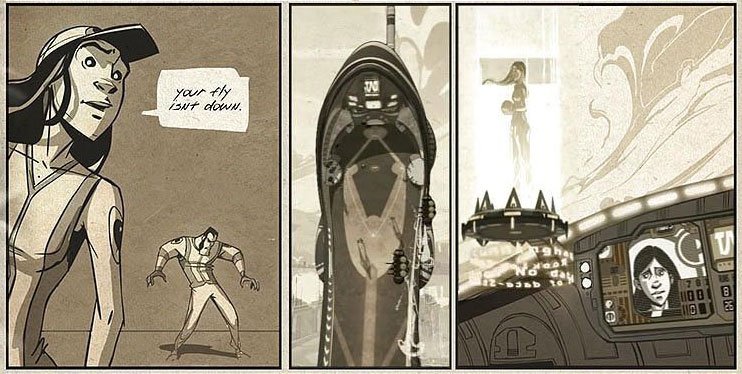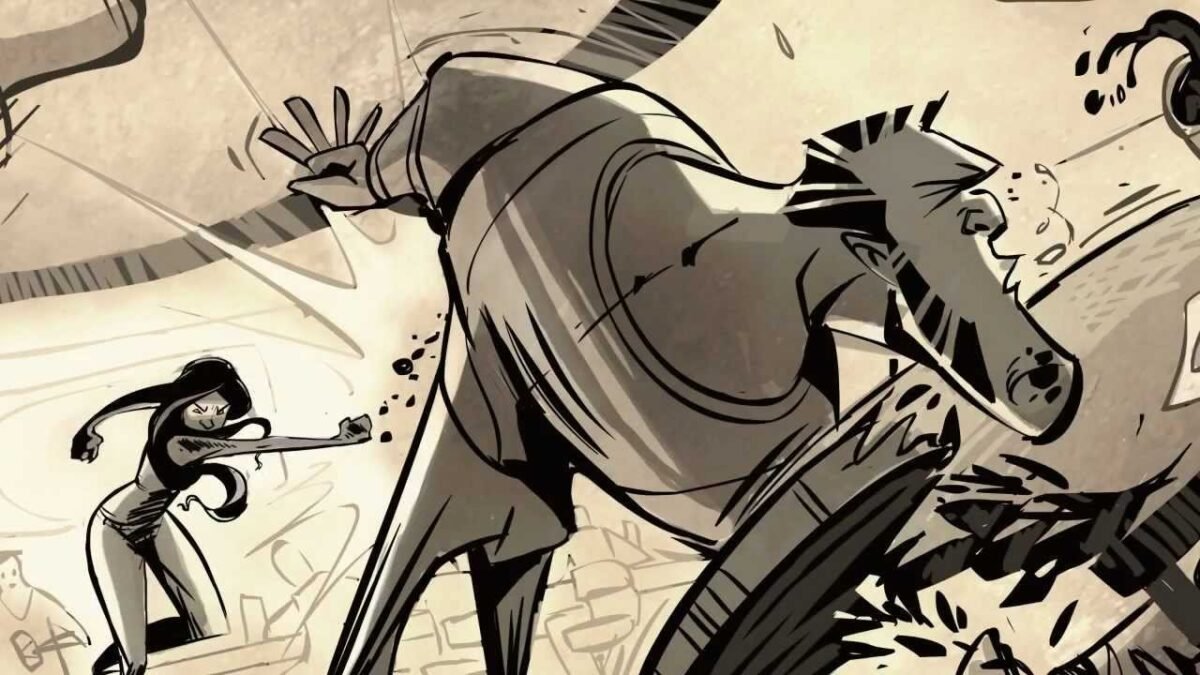Set 200 years in the future, Bottom of the Ninth takes place in the fictional Tao City. Baseball, once the great American past-time, has evolved into a newer, harsher sport.
New Baseball is a rough-and-tumble business, borrowing gladiator-like elements and employing a field of artificial gravity. Bottom of the Ninth follows Candy Cunningham, the talented 18-year-old daughter of former New Baseball star Gordy Cunningham. What sets Bottom of the Ninth apart from other graphics novels is its unique presentation.
Bottom of the Ninth is presented on an Apple iPad, and features an array of 3D and 2D animations rolled seamlessly into the panels. Bottom of the Ninth is essentially an animated graphic novel, although it’s best described as an audio-visual experience.
We spoke to the creator of Bottom of the Ninth, Ryan Woodward, about some of the challenges in bringing together 3D animation and the graphic novel storytelling experience.
How did you go about creating Bottom of The Ninth? It’s certainly a very different experience from your typical graphic novel.
Ryan Woodward: It’s basically a dream. I’ve always loved graphic novels and comics. That love for those stories is what motivated my interests into becoming an animator and storyboard artist. So I’ve often thought about how awesome it’d be to actually have a comic that would animate like the Harry Potter newspapers.
So when I started realizing that this iPad thing actually could provide me with a platform to create such an experience, I had to just go for it. My expertise is in story, art, design, animation, and compositing. I knew there was more than that needed in app development, but I felt I had a pretty good grasp on the meat of the content. It would just take a ton of work, which really isn’t work sometimes.

Bottom of the ninth is a blend of a baseball story with many sci-fi elements. How did you go about selecting two such differing elements and blending them together?
Ryan Woodward: How cool is that, huh? Taking a great Americana sport like baseball and evolving it into a sci-fi futuristic city that has the ability to generate artificial gravity where the players in the infield stand sideways! So I get to keep the nostalgic feel of baseball, but modify just enough to add interest and creativity to the story experience.
The funny thing is, Prologue – Issue 1, doesn’t really dive into the real meat of the story yet. It’s more of a set up for the characters and the world. The real meat of the story is a father/daughter relationship as they go through the challenges of Candy’s fame. Baseball, future city, artificial gravity and everything else is there to support that main story. In future issues that will become very apparent.
What sort of research and preparation did you perform before getting down to work?
Ryan Woodward: The relationship part was easy. I am raising three girls and not a day goes by that I wonder about their future, their talents, their successes in life. I think that is why the relationship between Candy and Gordy becomes so real. Because it’s based on a real father and three real daughters. The baseball stuff was a lot of fun to research.
I played little league as a kid, and softball for a time as an adult, but really studying the physical mechanics of a pitch and a bat swing is crazy similar to dancing. There’s a flow of energy that passes through the body and it allows the body to move weight in a way that it slingshots energy. Dance is so similar, it just has a different purpose and aesthetic. I studied the pitching of Tim Lincecum in the most detail. The way his torso moves and stretches would put most people in the hospital. It’s really beautiful.

Were there any challenges with blending science fiction into an aspect of everyday life that already has such as established set of lore behind it?
Ryan Woodward: Yeah, when you are creating a world, you have to ask yourself how each decision you are making is going to affect the culture of the city. Then if the culture is affected, how does that change the accepted behavior of the people and that affects their lifestyle, and you can see how this can keep going deeper and deeper. I wanted to create a city that was psycho over New Baseball. I know families that live and breathe sports teams. I wanted an entire city like that.
So, none of the buildings were scaled higher than the stadium to preserve it’s sanctity, the buildings were adorned with New Baseball advertisements and player endorsements, statues of past players stand at the city’s entrance and no matter how urgent the moment is, the people slow and give their respects to the “Greats.” There are baseball diamonds
everywhere, and everyone sports their allegiances to their teams. That type of culture effected everything else in the city.
How exactly does producing an experience like Bottom differ from producing a film, or a graphic novel?
Ryan Woodward: I started the process with the exact same approach. Pre-production consisted of script, beat boards, character designs, environment designs, etc. Production became animation, motion graphics, digital effects, modeling, rendering, etc. Post became compositing, music, and then coding. So the pipeline was not foreign to me. What was foreign was working around the limitations and power of the iPad.
There were so many great ideas we could have employed but chose to not go gimmicky. If the idea supported the characters or the story, we went with it. If it didn’t, and it was just there cause it’s a cool feature, I dropped it. Gimmicks lose their interest and their appeal fast. I want people to look at this app for a long time and still admire the hard work and content we put into it.

What were some of the unique challenges you faced when creating Bottom?
Ryan Woodward: Think of one production that ever succeeded that didn’t include any management? No producers, no production managers, no executives or shareholders calling the shots. This was entirely created by artists and now I know why good managers and producers are so valued. The hardest part for me was trying to keep all these scenes moving, problem solving and organizing while at the same time trying to animate and do all my artistic stuff.
I realize that I could have put in so much more animated content had I had good management and producers cause I could have focussed on directing and creating artwork. As the financier as well, it’s not a good idea to mix those. Toward the end of the production, every effort, every task was being measured by how much money it would cost and I started devoting too much time to controlling the budget and I think that affected my creativity. This entire experience was a huge experiment that gave us all an education in app development that typically takes years to learn. Luckily I had a great team that worked together, worked hard, and knew how to respect each other. Hats off to the crew!!
Were there any conflicts the vision that was in your head, and the technical limitations of the medium?
Ryan Woodward: Yeah. Despite the power of the technology, there are still some things you cannot do – or at least I couldn’t figure out. I wanted a lot more moving panels that subtly moved on page open. But the cpu of the iPad is limited, and the memory is limited. So we employed a lot of tricks to get the motion working and using a variety of file types. In the end, we really pushed the iPad and its load, but at least it’s not crashing on people. Memory purging had to be employed in the code quite frequently.
There were also some compression issues that I kind of got excited about. In an effort to keep file sizes down, yet limiting the number of movie files to play at once, I was able to create a process that gave us super clean moving files for a crazy low reduction in file size. I won’t say more there cause that process is what is really going to be employed in issue 2 and most developers are going to wonder how the hell we got file sizes down so low and that much animation on a page.

Obviously you had to work with both 3D and 2D content. Was it a challenge to merge those two together to make the experience look convincing?
Ryan Woodward: Oh yeah. I luckily have a great team and one of the guys on that team is Jared Greenleaf. He’s so great at keeping me in check. 3D has a way of enamoring the eye with how beautiful renders can look, and there was a point when the renders were really looking 3d and not matching the 2D comic look. Jared pointed that out and we scrapped a lot of material and re-thought the compositing of the render layers. As I look at the app now, I think we could have done a better job at that merge, but hey….lessoned learned…apply the knowledge….correct the error in the next app!
How do you think you will continue to develop the brand?
Ryan Woodward: I am in full businessman mode these days learning so much about the other side to art. But what I like about this is that I am utilizing every ounce of creativity in me to structure this company the best way I can for its future. I really don’t care about past models or proper business practices. I’m all about thinking way outside of that and trying something new.
If it fails, boom, lesson learned, try another practice. But in the end I don’t want a company that does things that same way everyone else does. I believe there are better ways, I just have to test and try them. I have a ton of ideas that I’m so anxious to tackle but one thing at a time. Right now, I’m focusing on building a base of fans and readers. If I can achieve that, then look out world, we’re gonna’ do things so cool!
Many journalists are dubbing your work as the future of the comics industry. Do you think your work is the future of graphic novels?
Ryan Woodward: Well, I can’t say what other companies are going to do but I do I want to do and I’ll keep doing it. I suspect that if we experience a degree of success, then we’ll probably see similar products popping up. That’s okay. But I can tell you we have a model in place that allows for us to make this type of quality for pennies on the dollar compared to other companies. If Marvel tackled a product similar to Bottom of the Ninth, they’d probably have to spend 10 times the budget and then the profit margin goes sour.
The app user paradigm needs to shift a bit though; currently, users will pay $15 bucks for an ebook, $10 for a movie ticket, and even $4 bucks for a print comic book. But in app space, if it’s not free, or, heaven forbid, asking for .99 cents, many users walk away. That is really tough to crack, which is why I have had to put my app to free. ‘Cause I need the fan base more than the revenue and even at .99 cents, that deters a lot of people from testing out a new product.

Was there anything that you really wished you could have included, but did not find a way to?
Ryan Woodward: Tons! The list goes on and on. I finally had to put the brakes on executing my ideas because I totally ran out of money and I mentally, physically and emotionally really needed to be done with the app. I have a very addictive personality and work ethic. I do not like to stop on any project unless it is complete and I didn’t stop working for over 6 months. That’s day, night, sleep, dinner table, church, mowing the lawn, it’s always there. AndIi was starting to go a little nuts.
As with any other science fiction style work, there is a bit of a challenge in making sure the readers can engage with your fiction. Do you think the baseball element allows for greater immersion?
Ryan Woodward: Not sure. Didn’t really do any research on that or focus groups or anything. In fact, the idea of basing creative decisions on previous accepted formulas just seems archaic to me. If the evidence is out
there that a certain demographic is attracted to a certain sport, then by implementing that sport, your product is only going to copy what’s already accepted.
Maybe it’s a unique spin, but it’s still a copy. I really don’t like focus groups or research data for that exact reason. I don’t want to do something that is already publicly accepted, I don’t want to follow some other creative leader that established that cultural appeal. I want to follow my gut and create something totally different. Hey, if the public denies it, then back to the drawing board. I remember pitching this story to a friend about 2 months before I went full speed ahead, and I remember him telling me that it’s a bad idea because baseball is an American sport and my audience would be restricted to baseball fans living in the US. He suggested I needed to find a plot line that appealed to the entire world.
That may be sound business advice in most practices, but man, that was the last thing I was going to do. I don’t want a watered down product that is so flat in story and characters because I’m trying to appeal to a global aesthetic. I want to create something from the heart, something individual and creative, and then acquire an audience that normally wouldn’t pick something like this off the shelf. Because when a person is sold on a product, when the previously didn’t know anything about it, that seems to have so much more of a lasting effect and loyalty than the generic formulaic success models. Who knows, maybe I’m just a dreamer and I’ll humbly admit my naiveté soon enough. But not for now.

How will the second issue differ?
Ryan Woodward: We’ll see. I don’t like to tie down too many things to early cause I like to work fluidly and change up things constantly. The ideas in issue 01, back in January, were completely different than what is in the app now. It’s way better now ‘cause we moved and modified and evolved and learned throughout the whole process. The story is fairly concrete, but I’m really excited to see what nutty ideas come out when we get working on two.
The official website lists Bottom as an animated graphic novel. Do you believe a new term should be created for this type of experience? The work seems to have outgrown being merely a graphic novel.
Ryan Woodward: I guess I’ll let the public decide that. I like to use the term animated graphic novel though. This is not a motion comic, that is a whole different product. It’s not an ebook and it’s not a motion book. It’s animated! And from my perspective, the story is more closely influenced by European graphic novels as opposed to American superhero comic books. So that’s what I’ll stick to. The one term I don’t like to hear is when “animation” is used when “motion graphics” is the proper description.
Animation defined is the illusion of life. If the movement communicates life, a conscience, a motivated character or world that is believable, that’s animation. If it’s moving text on the screen, a moving logo, or any object that moves just for movement’s sake, that’s motion graphics. Guess I’m a bit nerdy with that term, but that is how I was trained as an animator and it distinguishes the works value apart from the gimmicky stuff all over the internet these days.
Do you see other artists adopting similar techniques for integrating technology and graphic novels in the future? What advice would you offer them?
Ryan Woodward: Go for it! I’d love for more individuals to tackle something like this. In order to motivate me to improve faster, I need someone to do it better. And in a spirit of American capitalism and free enterprise, that encourages me to create an even better product if I want to compete for sales. That cycle continues and innovation thrives! Gotta love America. Man, I really hate government policies that undermine that principle. Oops! didn’t mean to go there! 🙂



